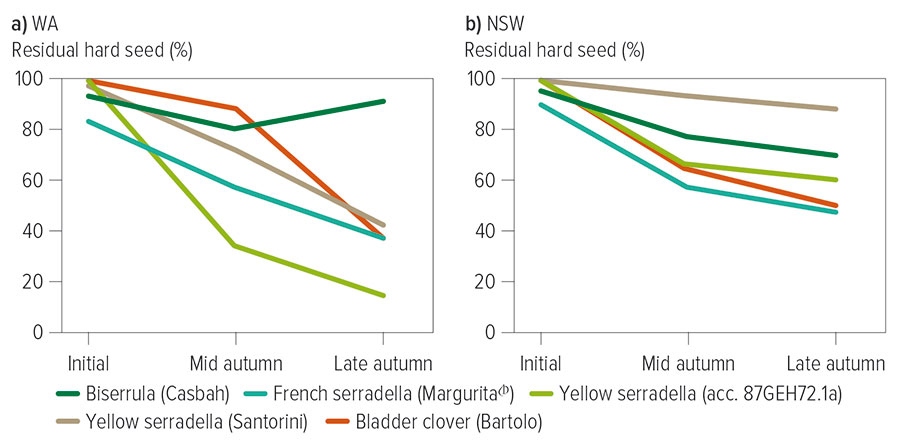New summer sowing strategies have been developed through the national Dryland Legume Pasture Systems project and customised for medium to low-rainfall zones where pastures are grown in rotation with crops. It is critical to check local trial results and grower experience to decide which species and variety are suited to summer sowing in your area.
This is because it is essential to match the patterns of hard-seed breakdown to the climatic and soil conditions that drive breakdown over summer and early autumn.
Initial field trials in Western Australia suggested bladder clover (Trifolium spumosum) and the hard-seeded French serradella cultivars (Ornithopus sativus) were suitable for summer sowing in WA’s hot, dry conditions during February and March.
However, a broader range of hard-seeded legume species proved suitable for summer sowing in southern New South Wales, including arrowleaf clover (Trifolium vesiculosum), gland clover (Trifolium glanduliferum), biserrula (Biserrula pelecinus) and some cultivars of yellow serradella (Ornithopus compressus).
Breakdown patterns
Hard-seededness is a form of dormancy, an evolutionary trait that ensures seeds do not germinate even in seemingly optimal conditions, or may germinate in a staggered fashion to spread the odds of survival.
Seed dormancy traits and their breakdown patterns can be genetically diverse and interact with local environments. The challenge has been to find species and varieties with optimum breakdown patterns to enable summer sowing in low to medium-rainfall zones of Australia.
Figure 1 shows the patterns of hard-seed breakdown of several pasture legumes in WA and NSW. The pattern displayed by biserrula in WA is clearly unsuitable for summer sowing, with less than 10 per cent of seed softening by late autumn, whereas more than 30 per cent softened in NSW.
Figure 1: The breakdown of five hard-seeded annual forage legumes over numerous environments in WA and NSW.
 Source: NSW DPI and Murdoch University
Source: NSW DPI and Murdoch University
In comparison, bladder clover, French serradella and yellow serradella (acc. 87GEH72.1a) had enough hard-seed breakdown over summer and into autumn in WA and NSW to be suitable for use in summer sowing.
It appears that hard-seed breakdown in many pasture legumes is faster in NSW compared with WA because of higher humidity, more frequent summer rain and soils with greater clay content, which help retain soil moisture for longer.
Residual hard-seed levels
The residual hard-seed levels are an important consideration when selecting species and variety for inclusion in crop rotations. This is a measure of how much of the seed produced in a given season will remain dormant by the following autumn and winter.
High levels of residual hard-seed mean the legume seedbank will be more persistent within a cropping rotation and will be able to regenerate after one or more crops without the need for resowing.
Generally, legume varieties with residual hard-seed of 40 to 60 per cent are well-suited to alternating years of pasture and crop. Given a couple of years of good legume growth and seed-set, a sufficient seedbank will be established to regenerate the legumes after two years of crop. For legumes with even higher hard-seed levels (more than 70 per cent), cropping phases of two to four years are feasible.
This sort of knowledge informs growers’ selection of appropriate species for their environment and their management and guides plant breeders in the development of future varieties suitable for changing climates.
This research was part of the national Dryland Legume Pasture Systems project supported by the Australian Government Department of Agriculture, Water and Environment (DAWE) Rural R&D for Profit program and the Grains Research & Development Corporation, Meat & Livestock Australia and Australian Wool Innovation.
More information: Robert Harrison, robert.harrison@csiro.au; Belinda Hackney, belinda.hackney@dpi.nsw.gov.au; Ron Yates, ronald.yates@dpird.wa.gov.au

























































